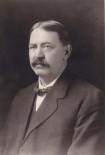 Henry Charles Trost
Henry Charles Trost
1860 – 1933
Birthplace – Toledo, Ohio
Henry Charles Trost was the second-born son of German immigrants Ernst and Wilhelmina. In 1850, the family settled in Toledo, Ohio. Ernst worked as a carpenter and Wilhelmina ran a family grocery store on Bush Street. Henry attended school and after graduation worked as an artist in Toledo.
In 1880, Henry left Toledo for Denver, Colorado. There he was employed as a draftsman for the firm of Nicholas & Canmen. He worked on the National Bank of Denver and Denver City Hall. The following year, Henry partnered with architect Frank A. Weston and opened an office in the Baxter Building. The firm received the commission for Colorado Springs City Hall building in 1882-1883 (demolished in 1930). Weston & Trost also received a contract as supervising architects for the Central High School under the architectural firm of Manning & Coon. The Harper Weekly carried the first publication showcasing Trost’s work as an architect.
During the 1880s, Henry retained his partnership with Weston however left Colorado for additional work. In 1883 and 1884, Henry spent some time in Galveston, working for architect Nicholas J. Clayton. On December 17, 1884, the World’s Industrial and Cotton Centennial Exposition opened in New Orleans. Henry left Texas to attend the expo. It is not possible to establish if he worked on any of the exhibition buildings.
In 1885, the firm of Haskell & Wood in Topeka Kansas employed Henry to work on the design of the Senate Chamber. Henry served a chief draughtsman. While in Kansas, Henry reinstated his partnership with Frank Weston. In December 1885, Weston & Trost drew up plans for a hotel in Dodge City for Mr. George B. Cox. The plans called fora structure to be erected on the site of the Dodge House stable. It is not known if the plans were carried out. Weston & Trost partnership ended by 1887.
In the years 1888-1896, Henry resided in Chicago. Henry was a member of the Chicago Sketch Club, later known as the Chicago Architectural Club. In November, 1888, during a competition, Henry submitted a sketch of the “Wrot iron Gates.” He was awarded second prize. In 1889, Henry formed the American Art Metal Company with partner Emil Henry Seeman. (23 and 25 Indiana Chicago, Illinois) The partnership lasted for a year. In 1892 to 1896, Trost then served as vice president of Chicago Ornamental Iron Company. The company received the commission for the metal ornament front railings of the boxes, balconies and stairways for the Lafayette Square Opera House in Washington D.C.
Henry returned to Colorado Springs during the years of 1896 to 1899. He continued his association with Weston, but nothing was ever found to be designed during this period. It was by the end of 1899, that Henry moved to Tucson, Arizona. Shortly after his arrival Henry received the commission to design the Steinway Home. (first Owls Club) During the competition for the Carnegie Library in Tucson, Henry met architect Robert Rust. They formed a partnership and received commission for several buildings in Tucson; Ronstadt building, Manning Residence, George Kitt Residence and University of Arizona South Hall.
In 1901, Henry took his first trip to El Paso from Tucson. He arrived to submit plans for the Bailey hotel. He revisited the city twice in 1902 and finally settled in El Paso in late 1903. Henry’s brother Gustavus was in El Paso serving as the supervisor for the building of Carnegie Library. The firm of Trost and Trost Architect is first listed in the City Directory in 1904. Adolphus who was Gustavus twin brother left Toledo to join the firm as the chief engineer in 1908. It is around this time that the firm begin the use of reinforced concrete in their buildings. ( Mills Building in El Paso) Over the next thirty years , the firm created some of most unique buildings in the southwest utilizing the landscape and the climate in all of their designs. Henry’s architectural styles ranges from prairie style (seen in the design of his home in El Paso), Mission Revival (featured in the First Owl Club in Tucson), Pueblo Revival (Franciscan Hotel in Albuquerque ), Bhutanese design ( University of Texas at El Paso) and the Chicago Art Deco ( Bassett Tower in El Paso).
Henry Trost passed away on September 19, 1933 and is buried at Evergreen Cemetery in El Paso, Texas.








